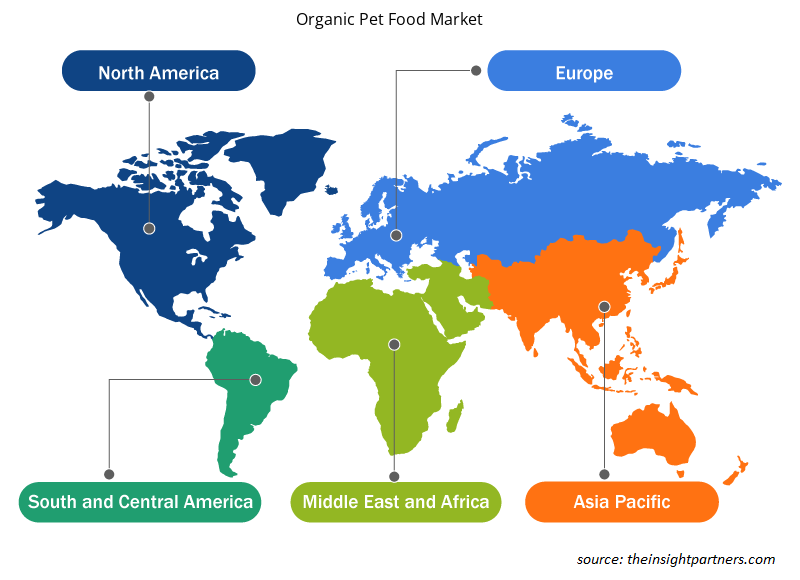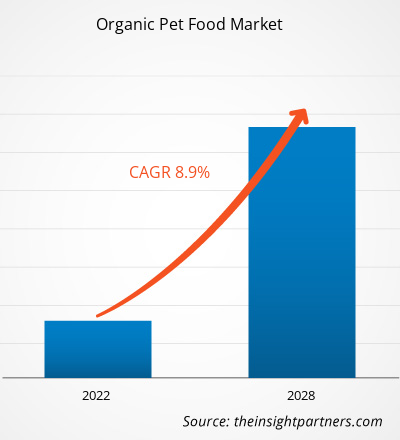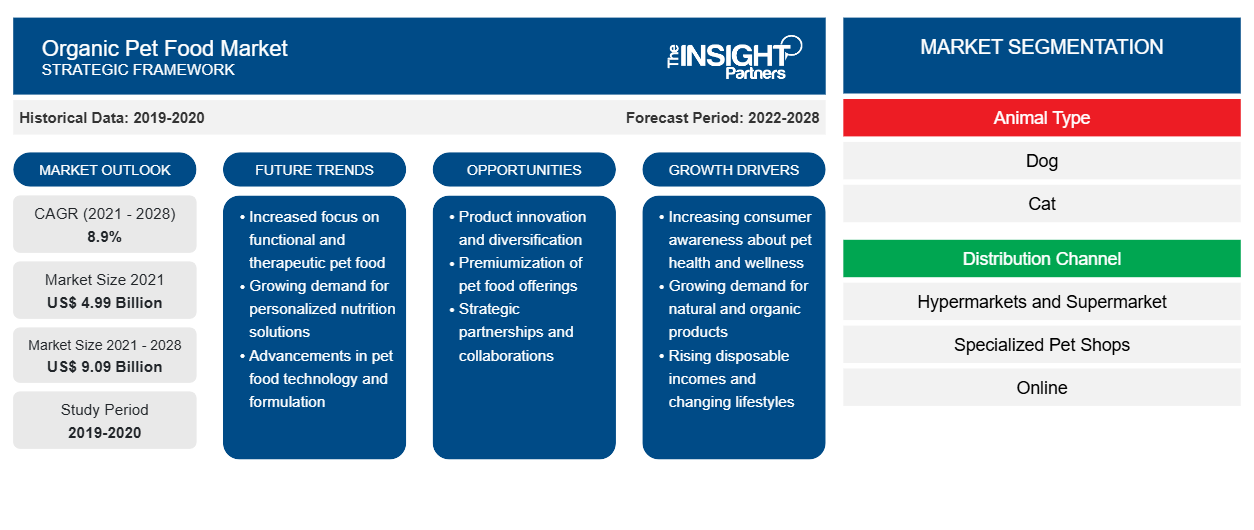Der Markt für Bio-Tiernahrung wurde im Jahr 2021 auf 4.991,54 Millionen US-Dollar geschätzt und soll bis 2028 9.090,20 Millionen US-Dollar erreichen; von 2021 bis 2028 wird ein durchschnittliches jährliches Wachstum von 8,9 % erwartet.
Bio-Tierfutter gewinnt an Bedeutung, da Haustiere zunehmend menschlicher werden und dadurch hohe Ausgaben für Tierprodukte entstehen. Verbraucher, die Bio-Produkte kaufen, übernehmen dasselbe Kaufverhalten für ihre Haustiere. Sie fordern Bio-Tierfutter mit sauberer Kennzeichnung, um die schädlichen Nebenwirkungen synthetischer und chemischer Zusatzstoffe in herkömmlichem Tierfutter zu vermeiden.
Im Jahr 2020 hatte Nordamerika den größten Anteil am globalen Markt für Bio-Tiernahrung . Allerdings wird der asiatisch-pazifische Raum im Prognosezeitraum voraussichtlich die höchste durchschnittliche jährliche Wachstumsrate (CAGR) auf dem Markt verzeichnen. Der asiatisch-pazifische Markt umfasst mehrere Entwicklungs- und Industrieländer wie China, Indien, Japan, Südkorea und Australien. Diese Volkswirtschaften erleben einen Anstieg der Mittelschichtbevölkerung, gepaart mit einer zunehmenden Urbanisierung, was den wichtigsten Akteuren auf dem Markt für Bio-Tiernahrung lukrative Möglichkeiten bietet. Die wachsende Haustierpopulation im asiatisch-pazifischen Raum und die steigende Neigung der Verbraucher zu Bio-Tiernahrung treiben das Marktwachstum an. Auch die zunehmende Vermenschlichung von Haustieren wird das Wachstum des Marktes für Bio-Tiernahrung im asiatisch-pazifischen Raum im Prognosezeitraum vorantreiben.
Passen Sie diesen Bericht Ihren Anforderungen an
Sie erhalten kostenlos individuelle Anpassungen an jedem Bericht, einschließlich Teilen dieses Berichts oder einer Analyse auf Länderebene, eines Excel-Datenpakets sowie tolle Angebote und Rabatte für Start-ups und Universitäten.
-
Holen Sie sich die wichtigsten Markttrends aus diesem Bericht.Dieses KOSTENLOSE Beispiel umfasst eine Datenanalyse von Markttrends bis hin zu Schätzungen und Prognosen.
Auswirkungen der COVID-19-Pandemie auf den Markt für Bio-Tiernahrung
Die COVID-19-Pandemie hat die Betriebseffizienz des Fertigungssektors aufgrund längerer Lockdowns in verschiedenen Regionen, Beschränkungen des internationalen Handels, Schließung von Produktionsstätten, Reiseverboten, Lieferkettenbeschränkungen und Rohstoffknappheit erheblich beeinträchtigt. Die Pandemie hat den globalen Markt für Bio-Tiernahrung aufgrund der Schließung von Produktionsstätten, steigender Rohstoffpreise, Arbeitskräftemangel, Unterbrechung der Lieferketten und finanzieller Instabilität beeinträchtigt. Die Regierungen verschiedener Länder verhängten Anfang 2020 Lockdowns, um die Ausbreitung des Virus einzudämmen, was sich wiederum negativ auf die Produktion von Bio-Tiernahrung auswirkte. Die Regierungen hatten die Tiernahrungshersteller aufgefordert, ihre Produktion zu verzögern, was sich negativ auf die weltweite Versorgung mit Lebensmitteln und Tiernahrung, einschließlich Bio-Tiernahrung, auswirkte. Seit 2021 bieten die Regierungen verschiedener Länder im asiatisch-pazifischen Raum jedoch Impfungen an und ergreifen Vorsichtsmaßnahmen, um die Ausbreitung des neuartigen Coronavirus einzudämmen. Die Regierungen haben außerdem ihre Betriebsabläufe neu ausgerichtet, ihre Produktionsanlagen umstrukturiert und die für Bio-Tiernahrung erforderlichen Rohstoffe im Voraus beschafft, um ein Ungleichgewicht zwischen Angebot und Nachfrage zu vermeiden. Darüber hinaus spielen E-Commerce-Netzwerke während der Pandemie eine wichtige Rolle bei der Verteilung von Lebensmitteln und Tiernahrung, und die Menschen kaufen die Produkte überwiegend lieber online.
Markteinblicke
Immer mehr Fälle lebensmittelbedingter Gefahren
Hygienisches und gesundes Tierfutter ist für die Gesundheit von Haustieren von grundlegender Bedeutung. Daher kaufen Tierbesitzer lieber hochwertiges Tierfutter. Als ganzheitlich, biologisch und natürlich gekennzeichnetes Futter zieht Kunden eher an als konventionelle Produkte. Im Allgemeinen wird Tierfutter aus Nebenprodukten der Lebensmittelindustrie wie Hühnerhaut und -knochen hergestellt. Solche Praktiken können zu durch Lebensmittel übertragenen Krankheiten führen, wenn die verwendeten Rohstoffe mit zusätzlichen Antibiotika versetzt werden. Die Lieferkette von Tierfutter vom ersten bis zum letzten Schritt der Verarbeitung muss aufrechterhalten werden, um durch Lebensmittel übertragene Krankheiten zu verhindern, die durch Tierfutter übertragen werden können. In vielen Fällen, in denen Besitzer ihre Haustiere mit rohem Tierfutter füttern, wurde eine Salmonellenkontamination festgestellt. Darüber hinaus kann die künstliche Anreicherung von Lebensmitteln die Gesundheit von Haustieren schädigen und den Markennamen beeinträchtigen. So rief die Marke Fromm Family Foods im Oktober 2021 Hundefutter zurück, da der Vitamin-D-Gehalt möglicherweise zu hoch war, was für Hunde schädlich sein dürfte. Die Organic Trade Association (OTA) meldete ein höheres Wachstum bei den Verkäufen von Bio-Tierfutter als bei Bio-Lebensmitteln für Menschen. Darüber hinaus wächst der Markt für Bio-Tierfutter seit dem Rückruf von Tierfutter durch Menu Foods Inc. im Jahr 2007, der in den USA zu 14 Todesfällen bei Tieren führte. Der Markt für Bio-Tierfutter erlebte einen enormen Umsatzanstieg aufgrund der Bedenken der Kunden gegenüber herkömmlichem Tierfutter. Daher wird Bio-Tierfutter als sichere Wahl bevorzugt. Daher wird erwartet, dass der Markt im Prognosezeitraum ein hohes Wachstum verzeichnen wird.
Einblicke in Produkttypen
Basierend auf dem Produkttyp ist der Markt für Bio-Tiernahrung in Trockenfutter, Nassfutter und andere unterteilt. Das Segment Trockenfutter hatte im Jahr 2020 den größten Marktanteil und wird im Prognosezeitraum voraussichtlich die höchste durchschnittliche jährliche Wachstumsrate auf dem Markt verzeichnen. Trockenfutter hat einen geringen Feuchtigkeitsgehalt und ist in verschiedenen Formen erhältlich, beispielsweise als Pellets, Kroketten und Getreideflocken. Trockenfutter für Hunde wird durch Kombinieren und Kochen von Zutaten wie Fleisch und Getreide hergestellt. Trockenfutter für Haustiere sorgt für die Zahngesundheit von Hunden und Katzen, indem es die Plaquebildung reduziert. Trockenfutter für Haustiere muss nicht gekühlt werden, was der Hauptvorteil ist. Das Futter enthält neben dem täglichen Nährstoffbedarf auch Mikronährstoffe.
Einblicke in die Haustierart
Basierend auf der Art des Haustiers ist der Markt für Bio-Tierfutter in Hunde, Katzen und andere unterteilt. Das Segment Hunde hatte im Jahr 2020 den größten Marktanteil, während das Segment Katzen im Prognosezeitraum voraussichtlich die höchste durchschnittliche jährliche Wachstumsrate auf dem Markt verzeichnen wird. Katzen sind bei Menschen auf der ganzen Welt eines der beliebtesten Haustiere. Katzen sind obligate Fleischfresser. Ihre Ernährungsbedürfnisse unterscheiden sich von denen anderer Tiere. Aminosäuren wie Taurin, Arginin, Histidin, Isoleucin, Leucin, Lysin, Methionin, Phenylalanin, Threonin, Tryptophan und Valin sind für ihr Wachstum, ihre Fortpflanzung, ihre Darmgesundheit und ihre Knochengesundheit unerlässlich. Darüber hinaus ist Taurin im Allgemeinen in tierischen Mahlzeiten enthalten. Darüber hinaus benötigen Katzen eine beträchtliche Menge an Vitamin A für ihr Wachstum und Wohlbefinden. Das Bio-Tierfutter wird jetzt mit verschiedenen Mikronährstoffen angereichert, die für das Wachstum und das allgemeine Wohlbefinden der Katzen unerlässlich sind, was die Nachfrage nach Bio-Tierfutter für Katzen steigert. Die innovativen Produkte, wie etwa pflanzliche Nassfutter-Leckerlis, dürften die Nachfrage im Katzensegment auf dem Markt für Bio-Tiernahrung weiter ankurbeln.
Einblicke in Vertriebskanäle
Basierend auf den Vertriebskanälen ist der Markt für Bio-Tiernahrung in Supermärkte und Hypermärkte, Fachgeschäfte, Online-Einzelhandel und andere segmentiert. Das Segment Supermärkte und Hypermärkte hatte im Jahr 2020 den größten Marktanteil, während das Segment Online-Einzelhandel im Prognosezeitraum voraussichtlich die höchste durchschnittliche jährliche Wachstumsrate (CAGR) auf dem Markt verzeichnen wird. E-Commerce-Plattformen bieten Kunden auf der ganzen Welt eine breite Palette von Produkten verschiedener Kategorien. Verbraucher können das Produkt ihrer Wahl von zu Hause oder vom Büro aus kaufen. Der Online-Einzelhandel ist der am schnellsten wachsende Vertriebskanal für Bio-Tiernahrung aufgrund der einfachen Zugänglichkeit, der Verfügbarkeit einer breiten Produktpalette und der Bequemlichkeit, die diese Kanäle in Bezug auf die Lieferung der Produkte, Cashback, Rabattcoupons und attraktive Angebote bieten. Darüber hinaus wird der Markt für das Segment Online-Einzelhandel in den kommenden Jahren voraussichtlich ein deutliches Wachstum verzeichnen, da der Einkauf in physischen Geschäften im Zuge der COVID-19-Pandemie eingeschränkt ist.
Tender and True Pet Nutrition; Castor and Pollux Natural Petworks; Nestlé; Raw Paws Pet, Inc.; NATIVE PET; Primal Pet Foods; Yarrah Organic Petfood BV; Organic Paws; Petcurean und Evangers gehören zu den wichtigsten Akteuren auf dem Markt für Bio-Tiernahrung. Diese Unternehmen bieten dem Markt ein breites Produktportfolio. Die Marktteilnehmer entwickeln qualitativ hochwertige und innovative Produkte, um die Anforderungen der Kunden zu erfüllen. Die Unternehmen führen Bio-Varianten der meistverkauften konventionellen Tierfutter ein, um der wachsenden Nachfrage nach Bio-Tiernahrung gerecht zu werden. So werden pflanzliche Tiernahrungsprodukte jetzt in Kategorien mit Bio-Label eingeführt, die in Geschmacksrichtungen wie Cranberry, Rote Bete und Karotten erhältlich sind.
Regionale Einblicke in den Markt für Bio-Tiernahrung
Die regionalen Trends und Faktoren, die den Markt für Bio-Tiernahrung im Prognosezeitraum beeinflussen, wurden von den Analysten von Insight Partners ausführlich erläutert. In diesem Abschnitt werden auch die Marktsegmente und die Geografie von Bio-Tiernahrung in Nordamerika, Europa, im asiatisch-pazifischen Raum, im Nahen Osten und Afrika sowie in Süd- und Mittelamerika erörtert.

- Erhalten Sie regionalspezifische Daten zum Markt für Bio-Tiernahrung
Umfang des Marktberichts über Bio-Tiernahrung
| Berichtsattribut | Details |
|---|---|
| Marktgröße im Jahr 2021 | 4,99 Milliarden US-Dollar |
| Marktgröße bis 2028 | 9,09 Milliarden US-Dollar |
| Globale CAGR (2021 - 2028) | 8,9 % |
| Historische Daten | 2019-2020 |
| Prognosezeitraum | 2022–2028 |
| Abgedeckte Segmente |
Nach Tierart
|
| Abgedeckte Regionen und Länder |
Nordamerika
|
| Marktführer und wichtige Unternehmensprofile |
|
Marktdichte von Bio-Tiernahrung: Auswirkungen auf die Geschäftsdynamik verstehen
Der Markt für Bio-Tiernahrung wächst rasant, angetrieben von der steigenden Nachfrage der Endverbraucher aufgrund von Faktoren wie sich entwickelnden Verbraucherpräferenzen, technologischen Fortschritten und einem größeren Bewusstsein für die Vorteile des Produkts. Mit der steigenden Nachfrage erweitern Unternehmen ihr Angebot, entwickeln Innovationen, um die Bedürfnisse der Verbraucher zu erfüllen, und nutzen neue Trends, was das Marktwachstum weiter ankurbelt.
Die Marktteilnehmerdichte bezieht sich auf die Verteilung der Firmen oder Unternehmen, die in einem bestimmten Markt oder einer bestimmten Branche tätig sind. Sie gibt an, wie viele Wettbewerber (Marktteilnehmer) in einem bestimmten Marktraum im Verhältnis zu seiner Größe oder seinem gesamten Marktwert präsent sind.
Die wichtigsten auf dem Markt für Bio-Tiernahrung tätigen Unternehmen sind:
- TENDER & TRUE PET NUTRITION
- CASTOR & POLLUX NATÜRLICHE HAUSTIERWERKE
- Schmiegen
- Gesellschaften, beginnend mit RAW
- EINHEIMISCHES HAUSTIER
Haftungsausschluss : Die oben aufgeführten Unternehmen sind nicht in einer bestimmten Reihenfolge aufgeführt.

- Überblick über die wichtigsten Akteure auf dem Markt für Bio-Tiernahrung
Bericht-Spotlights
- Fortschrittliche Branchentrends im Markt für Bio-Tiernahrung helfen den Akteuren bei der Entwicklung wirksamer langfristiger Strategien
- In Industrie- und Entwicklungsländern angewandte Strategien für Unternehmenswachstum
- Quantitative Analyse des Marktes für Bio-Tiernahrung von 2019 bis 2028
- Schätzung der weltweiten Nachfrage nach Bio-Tiernahrung
- Porters Fünf-Kräfte-Analyse zur Veranschaulichung der Wirksamkeit von Käufern und Lieferanten in der Branche
- Aktuelle Entwicklungen zum Verständnis des wettbewerbsorientierten Marktszenarios
- Markttrends und -aussichten sowie Faktoren, die das Wachstum des Marktes für Bio-Tiernahrung vorantreiben und bremsen
- Unterstützung im Entscheidungsprozess durch Aufzeigen von Marktstrategien, die das kommerzielle Interesse untermauern und zum Marktwachstum führen
- Die Größe des Marktes für Bio-Tiernahrung an verschiedenen Knotenpunkten
- Detaillierte Übersicht und Segmentierung des Marktes sowie der Dynamik der Bio-Tiernahrungsindustrie
- Größe des Bio-Tiernahrungsmarktes in verschiedenen Regionen mit vielversprechenden Wachstumschancen
Markt für Bio-Tiernahrung – nach Produkttyp
- Trockenfutter
- Nassfutter
- Sonstiges
Markt für Bio-Tiernahrung – nach Haustierart
- Hunde
- Katzen
- Sonstiges
Markt für Bio-Tiernahrung – nach Vertriebskanälen
- Supermärkte und Hypermärkte
- Fachgeschäfte
- Online-Einzelhandel
- Sonstiges
Firmenprofile
- Zarte und wahre Tierernährung
- Castor und Pollux Natural Petworks
- Schmiegen
- Raw Paws Pet, Inc.
- EINHEIMISCHES HAUSTIER
- Primal Tiernahrung
- Yarrah Organic Petfood BV
- Bio-Pfoten
- Petcurean
- Evangers
- Historische Analyse (2 Jahre), Basisjahr, Prognose (7 Jahre) mit CAGR
- PEST- und SWOT-Analyse
- Marktgröße Wert/Volumen – Global, Regional, Land
- Branchen- und Wettbewerbslandschaft
- Excel-Datensatz
Aktuelle Berichte
Verwandte Berichte
Erfahrungsberichte
Grund zum Kauf
- Fundierte Entscheidungsfindung
- Marktdynamik verstehen
- Wettbewerbsanalyse
- Kundeneinblicke
- Marktprognosen
- Risikominimierung
- Strategische Planung
- Investitionsbegründung
- Identifizierung neuer Märkte
- Verbesserung von Marketingstrategien
- Steigerung der Betriebseffizienz
- Anpassung an regulatorische Trends























 Kostenlose Probe anfordern für - Markt für Bio-Tiernahrung
Kostenlose Probe anfordern für - Markt für Bio-Tiernahrung